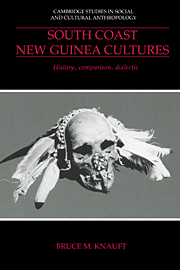Book contents
- Frontmatter
- Contents
- List of figures
- List of tables
- Acknowledgments
- 1 Language-culture areas of south coast New Guinea
- Part 1 Grounding
- 1 Theoretical and ethnographic context
- 2 Historical background and regional configuration
- Part 2 Critique
- Part 3 Reconfiguration
- Appendix: evidence concerning Asmat homosexuality
- Notes
- List of references
- Index
- Cambridge Studies in Social and Cultural Anthropology
1 - Theoretical and ethnographic context
from Part 1 - Grounding
Published online by Cambridge University Press: 04 December 2009
- Frontmatter
- Contents
- List of figures
- List of tables
- Acknowledgments
- 1 Language-culture areas of south coast New Guinea
- Part 1 Grounding
- 1 Theoretical and ethnographic context
- 2 Historical background and regional configuration
- Part 2 Critique
- Part 3 Reconfiguration
- Appendix: evidence concerning Asmat homosexuality
- Notes
- List of references
- Index
- Cambridge Studies in Social and Cultural Anthropology
Summary
How can anthropologists describe and compare ethnographic regions? Much information has been gathered since the nineteenth century that assumes a satisfactory answer to this question, but the problems that attend it are larger than ever. As emphasized from a politicoeconomic perspective, ethnographic regions are interwoven through trade, coercion, and economic dependence or political domination, particularly as states engage their ever-shrinking peripheries (e.g., Wolf 1982, 1988; Lomnitz-Adler 1991). As a result, the autonomy, divisibility, and uniqueness of ethnographic regions cannot be assumed.
From a postmodern perspective, the ethnographic characterization of culture areas and regions is an artifact – the result of a Western academic discourse that projects its own cultural biases and assumes incorrectly that these characterizations reflect other people's reality (e.g., Clifford and Marcus 1986; Clifford 1988; Boon 1990). Culture area comparisons thus neglect the irreducible authority of indigenous voices and collapse them into pigeon-holed categories deriving from the analyst's own time, place, and disposition. What becomes untenable from both the postmodern and the politicoeconomic vantage point is synchronic objectivism: the assumption that cultures have coherent, stable traits that render them comparable within the analytic space of a timeless ethnographic present.
In the current academic climate, few can deny the intellectual importance of these two critiques, much less their scholarly influence.
- Type
- Chapter
- Information
- South Coast New Guinea CulturesHistory, Comparison, Dialectic, pp. 3 - 24Publisher: Cambridge University PressPrint publication year: 1993



